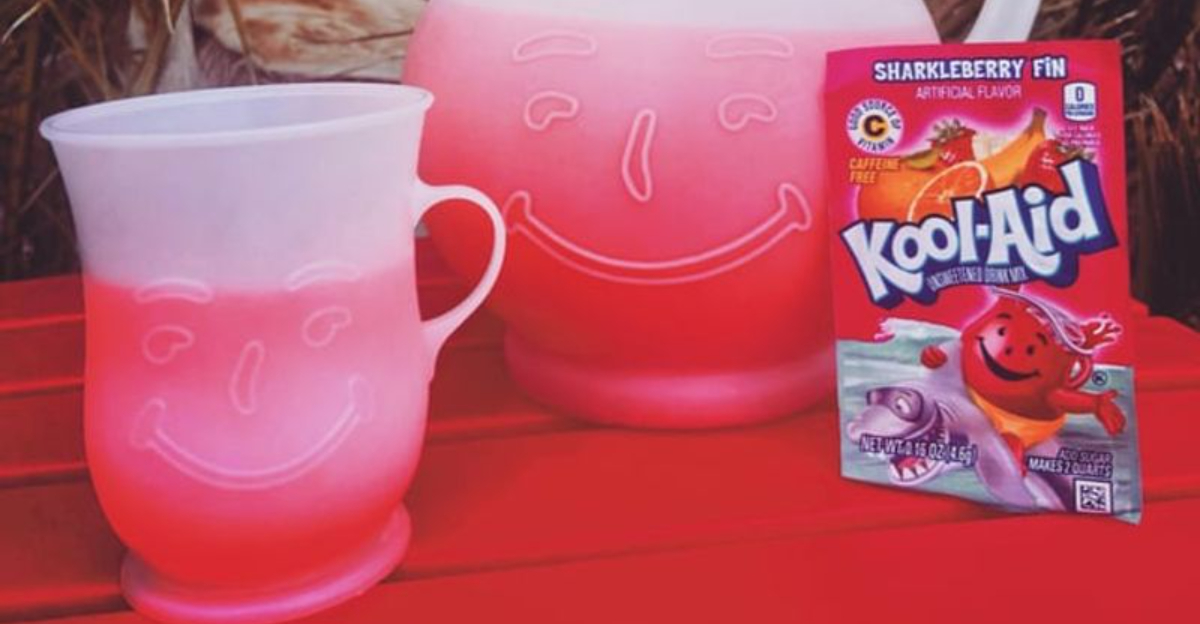20 Legendary American Snacks The Rest Of The World Just Doesn’t Get

Americans have a unique snack culture that often leaves international visitors scratching their heads.
From sweet-savory combos to ultra-processed munchies, these treats hold a special place in the American heart but remain mysterious to the rest of the world.
Join me as we explore these iconic American snacks that somehow never quite translated across oceans.
1. Peanut Butter and Jelly Sandwiches
The humble PB&J sandwich makes foreigners wrinkle their noses in confusion. Many cultures view peanut butter as too sticky, too sweet, or just plain weird. I still remember offering my Italian exchange student his first PB&J.
His face contorted like I’d handed him a sandwich filled with mud! Americans grow up on this protein-packed lunch staple, but the rest of the world sees it as a strange culinary experiment.
2. Cheese in a Can
Easy Cheese defies all international cheese standards. This bright orange, shelf-stable dairy product sprays from an aerosol can directly onto crackers, creating instant snacking magic.
No self-respecting French or Italian person would ever consider this actual cheese. Yet Americans happily squirt this processed wonder onto everything from celery sticks to hot dogs without a second thought.
3. Flamin’ Hot Cheetos
These neon red corn puffs leave fingers stained and tongues burning. Invented by a Frito-Lay janitor who became an executive, they’ve become a cultural phenomenon in America.
Growing up, my school banned them because kids would touch library books with bright red fingers! The intense artificial flavor and radioactive appearance make them a uniquely American obsession that bewilders visitors from countries with more subtle snack preferences.
4. Twinkies
Golden sponge cakes with creamy filling that supposedly never expire. These iconic treats have survived bankruptcy, urban legends, and even deep-frying experiments at state fairs. Last summer, I brought a box to a beach picnic with international friends.
My German buddy examined it like a scientist with a new specimen! The artificial ingredients and extreme shelf-life of Twinkies perfectly represent America’s love affair with convenience foods that puzzle health-conscious foreigners.
5. Beef Jerky
Strips of dried, preserved meat enjoyed as casual snacks baffle many international visitors. Americans munch on these leathery protein strips during road trips, hikes, and even office breaks. The concept of meat as a convenience food isn’t universal.
While dried meats exist globally, the American version’s preservatives, intense smokiness, and role as everyday snacking rather than survival food makes foreigners do a double-take at gas station jerky displays.
6. S’mores
Graham crackers, chocolate squares, and fire-roasted marshmallows combined into messy, melty sandwiches puzzle international visitors. This campfire treat represents pure Americana. The very concept of graham crackers doesn’t exist in most countries.
Add our obsession with deliberately burning marshmallows and you’ve got a uniquely American ritual. While the ingredients exist globally, the specific combination and cultural significance of s’mores remains distinctly red, white, and blue.
7. Corn Dogs
Hot dogs impaled on sticks, dipped in cornmeal batter, and deep-fried until golden brown. This state fair staple epitomizes American ingenuity – making hand-held food even more portable. I’ll never forget taking my Japanese friend to her first county fair.
She stared at my corn dog like I was eating an alien life form! The concept of coating processed meat in sweet cornbread batter seems perfectly normal to Americans but strikes foreigners as a bizarre culinary experiment.
8. Pumpkin Spice Everything
Americans go crazy for pumpkin spice each fall. This cinnamon-nutmeg-clove blend flavors everything from coffee to cookies, cereal to candles. The seasonal obsession reaches levels that bewilder international observers.
While pumpkin itself is universal, our cultural attachment to this specific spice blend as a limited-time flavor explosion creates annual frenzy.
Most foreigners can’t understand why we transform perfectly good coffee into what they consider a scented candle in a cup.
9. Hershey’s Chocolate
America’s iconic chocolate has a distinct tangy flavor that Europeans often describe as “sour” or “like vomit.” This comes from butyric acid formed during production. Americans grow up with this flavor profile and find European chocolates overly sweet or bland.
The chocolate divide is so real that when I visited Switzerland, my host family politely refused my gift of Hershey’s Kisses after one tentative taste. Our chocolate patriotism remains unshaken despite international chocolate snobbery.
10. Pop-Tarts
Rectangular pastry pockets filled with sugary filling and topped with frosting and sprinkles. Americans happily eat these for breakfast, which horrifies health-conscious foreigners.
The concept of a shelf-stable pastry that doesn’t require refrigeration already seems suspicious to many international visitors. When they learn we feed these sugar bombs to children before school, their cultural shock is complete.
Yet Pop-Tarts remain a nostalgic comfort food for generations of Americans.
11. Peanut Butter Cups
Chocolate cups filled with sweetened peanut butter create a flavor combination that’s second nature to Americans but strange to many foreigners. The peanut butter-chocolate pairing is distinctly American.
Many countries view peanut butter as a savory spread only. The idea of sweetening it and pairing with chocolate seems odd abroad.
Meanwhile, Americans have elevated this combo to an art form, with Reese’s Peanut Butter Cups ranking among our most beloved candy innovations.
12. Kool-Aid
Brightly colored, artificially flavored drink mix that turns water into liquid sugar. The neon colors alone make international visitors question American beverage choices.
Growing up, Kool-Aid was a summer staple. My mom would make pitchers of the electric blue “flavor” I loved. When my cousin visited from England, she couldn’t believe we willingly drank something that looked radioactive!
The concept of flavoring water with artificial powder rather than using fruit juice remains peculiarly American.
13. Velveeta Cheese
This processed cheese product melts like a dream but barely qualifies as cheese to international standards. The smooth, uniform texture and neon orange color make cheese connoisseurs shudder. Americans love it for nachos, mac and cheese, and dips.
The block comes shelf-stable in a box, which alone is enough to make Europeans question our dairy standards. Yet nothing creates that perfectly smooth queso dip like Velveeta, a fact Americans defend with patriotic fervor.
14. Circus Peanuts
Orange, peanut-shaped marshmallow candies that taste vaguely of banana. These confusing treats combine colors, shapes, and flavors that have no logical connection. Even many Americans find these controversial.
Last Halloween, I put out a bowl of these spongy oddities, and my neighbor’s kid asked, “What did I do wrong to deserve these?”
Their bizarre texture and flavor profile make them perhaps the most difficult American candy to explain to foreigners.
15. Sweet Tea
Tea brewed hot, heavily sweetened while still warm, then chilled and served over ice. The sugar content makes international tea drinkers recoil in horror. Southern sweet tea isn’t just sweet – it’s practically syrup.
During my first visit to Georgia, I watched my host add two full cups of sugar to a gallon of tea! British visitors especially find our cold, sugary version of their national beverage particularly offensive, yet it remains the unofficial house wine of the American South.
16. Jell-O Salad
Fruit, vegetables, and sometimes meat suspended in flavored gelatin. These wobbly, colorful side dishes appear at potlucks and holiday meals across America.
The concept of savory ingredients in sweet, artificially flavored gelatin makes perfect sense to many American grandmothers but horrifies international visitors.
My great-aunt’s lime Jell-O with shredded carrots and canned pineapple was a Thanksgiving tradition that my Swedish exchange student politely declined with visible concern.
17. Frito Pie
Corn chips smothered in chili, cheese, and onions, often served in the actual chip bag. This Tex-Mex creation exemplifies American casual dining ingenuity. The concept of using a snack food as the base for a meal seems strange to many international visitors.
At a football game, my Brazilian friend watched in amazement as I cut open a Fritos bag lengthwise and loaded it with toppings. “You Americans will turn anything into a plate!” he laughed.
18. Marshmallow Fluff
Jarred, spreadable marshmallow cream that Americans put on sandwiches. The Fluffernutter (peanut butter and Fluff sandwich) represents peak American sandwich creativity. The concept of marshmallow as a spread rather than a discrete candy bewilders international visitors.
When I made Fluffernutters for my nephew’s birthday party, his German friend’s mother asked if it was shaving cream! The sticky, ultra-sweet spread remains a nostalgic favorite despite its complete nutritional void.
19. Little Debbie Snack Cakes
Individually wrapped, shelf-stable pastries with names like Cosmic Brownies, Oatmeal Creme Pies, and Star Crunch. These lunchbox treats represent American snack engineering at its finest. The concept of cakes that never spoil raises eyebrows internationally.
The bright colors, long ingredient lists, and perfect uniformity make them distinctly American. Yet generations have grown up trading these wrapped treasures at school lunch tables, creating a shared cultural experience that transcends their questionable nutritional profile.
20. Cheez Whiz
Processed cheese sauce in a jar that maintains a smooth, pourable consistency without refrigeration. This bright orange concoction is essential for authentic Philly cheesesteaks. The very concept makes cheese-producing nations shudder.
During a homestay in France, I mentioned Cheez Whiz to my host family. They were genuinely concerned about American food safety!
The convenience and uniform flavor of this shelf-stable “cheese” perfectly represents America’s practical approach to traditional foods.
